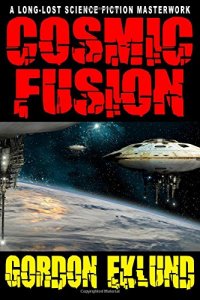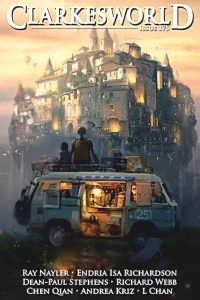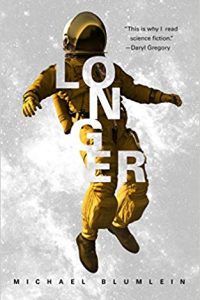Paul Di Filippo reviews Gordon Eklund
Cosmic Fusion, by Gordon Eklund (Wildside Press 978-1479423859, $19.99, 526pp, trade paperback) October 2016
 Few occasions give more pleasure to a reader than witnessing the unexpected return to print of a long-silent author who once had a rewarding, admirable career. This time around, the satisfaction derives from the appearance of Cosmic Fusion, by Gordon Eklund. Eklund had a solid run once, starting with his first story sale in 1970 and up to about 1989. I certainly collected and enjoyed his work during this period. Then he left the field, and writing in general. That era of his departure was nigh onto thirty years ago, and his voice has been missed. All credit, then, to Eklund for revivifying himself, and to Wildside Press for bringing the new work to us.
Few occasions give more pleasure to a reader than witnessing the unexpected return to print of a long-silent author who once had a rewarding, admirable career. This time around, the satisfaction derives from the appearance of Cosmic Fusion, by Gordon Eklund. Eklund had a solid run once, starting with his first story sale in 1970 and up to about 1989. I certainly collected and enjoyed his work during this period. Then he left the field, and writing in general. That era of his departure was nigh onto thirty years ago, and his voice has been missed. All credit, then, to Eklund for revivifying himself, and to Wildside Press for bringing the new work to us.
Now, admittedly, this novel is a “trunk” book. As Eklund states in his preface, it was written circa 1973-1982, contracted for, paid for, then never published, for reasons unknown. (Although Eklund makes some speculations.) Now it’s been dusted off and polished a tad, and finally gets a public viewing.
The book, Eklund promises, is one of those kind of SF novels that don’t really seem to get written much anymore. Syncretic, philosophical, all-encompassing, jam-packed with every notion the writer could squeeze in. Somehow emblematic of a whole worldview or the zeitgeist. Maybe the first such book was Charles Harness’s The Paradox Men. Bester’s two classics fall a bit into this realm. Delany’s Nova fixed the template. Then we had Piers Anthony’s Macroscope, John Brunner’s Stand on Zanzibar and George Zebrowski’s Macrolife. A fantasy equivalent might be Crowley’s Little, Big; while today Kim Stanley Robinson dips partially into the mode with a book like 2312. One might think of these titles as the SF analogue to “The Great American Novel.” And just as “The Great American Novel” seldom gets attempted any longer—for reasons of cultural fragmentation and multiplicity of voices—so too has this type of SF novel faded from the scene.
Upon reading, Cosmic Fusion does not resemble the titles I’ve cited so much as it resembles a couple of other strains of science fiction from about its era of composition. That would be the Vonnegut-style tragicomic homage to SF, and the High Camp Anarchist SF of Buckaroo Banzai and the Illuminatus Trilogy. As such it has an unmistakable ambiance of that period, while still remaining fun and fresh and relevant—especially since folks really aren’t writing this kind of book much any more.
The narrative, we shall soon see, is rife with allusions to past SF.
First up is a Doc Savage scenario. Our hero is one Desmond Blue, a giant of a fellow who is dubbed the world’s greatest detective (echoes of Holmes and Batman here) and who has a trio of followers much like Doc did with is five-man crew. There’s Gordon Schwerner, a genius yet maladjusted biologist raised as an orphan by robots. Schwerner happens to have succeeded in creating life from scratch, resulting in two beautiful androgynous androids named Jai and Lai, who will figure in the plot. Next is Alfie Jarrett, a kind of tough-guy hood. Third is Peter Mark, part cyborg along the lines of DC Comics’ Robotman. (There’s kind of a Doom Patrol vibe to this setup as well.) Blue also boasts three gorgeous female secretaries, in the manner of Heinlein’s Jubal Harshaw.
Blue and his crew inhabit a post-apocalyptic Earth. What happened, as backstory, is this: aliens came, destroyed much infrastructure; and murdered then inexplicably revived millions of people, now known as “spooks.” (Blue’s wife was tragically one such victim.) Naturally, all national and international power relationships and polities were shot to hell and reconfigured by the alien invasion. For instance, there are independent “spook reservations.” What we have in the USA is a kind of “Fragmented America” like the scenario famously patented by Ron Goulart circa 1968. The characters take all this merely for granted.
In a fallow period, Blue is intrigued when he learns that a secretive agency has perfected a time-viewer. But in looking at photos taken with the device, he notes anomalous figures in several scenes that alert him to the presence of actual time travelers who are warping history. These villains are known as the Sect, and Blue sets out to track them down and stymie them.
He dispatches Alfie to San Francisco, a city in ruins which is now the private preserve of millionaire John Hartford Hennesey (and his beautiful daughter Tess). Hennesey, it eventuates, is building the first FTL spaceship. The discerning reader quickly detects parallels with Heinlein’s “The Man Who Sold the Moon.”
Peter, meanwhile, is off in Winesap, Illinois, a bucolic community where book-burning by firemen is the rule, and a frustrated SF writer named Roy Goldman is the local black sheep.
Schwerner ends up in Africa where, among other exploits, he meets the four disabled children who together form a gestalt personality known as the Linkage. (Cue Sturgeon, natch.)
Blue himself jaunts all over the planet, eventually ending up at the hidden colony known as Futura, in deepest Tibet. Might I mention here the presence of an intelligent computer named Isaac that specializes in psychohistory? The mystery and menace of the Sect will be defused, but not in the manner expected. A Kilgore Trout-style coda wraps things up.
Eklund maintains these four separate threads with brio and with tongue firmly planted in cheek. Farcical exploits of a Marx Brothers nature proliferate wildly. Here’s a sample of the deadpan yet hyperbolic prose and style.
As Desmond Blue hastened through the nighttime streets of old Kabul accompanied by the disguised dwarf Louie Roth on the way to the offices of Dr. Ling Chi Ho, dentist and erstwhile criminal mastermind, he was reminded of an earlier occasion he had visited this fascinating city.
It was some years ago now—on his honeymoon. I was a different man then, thought Blue: tall, lean, lanky, dapper, handsome in his own peculiar way with a strong direct gaze, gentle mouth, firm sensitive jaw. Doctor Desmond Blue, psychoanalyst (Dezi to my friends.) Not yet celebrated in any sense but a dedicated practitioner of an honest trade.
And madly in love too. With the lovely young woman he’d only recently wed.
There are numerous entertaining side excursions into matters of sex, culture, history, science and philosophy—as well as quirky backstories for all the protagonists—but they do not totalize to the overarching weltanschauung of, say, Stranger in a Strange Land.
Ultimately, the book achieves a kind of manic droll world-weary humor like a fusion of Philip Jose Farmer and Neal Barrett. Not a negligible achievement, and one that should have seen the light of day much earlier, when the book could have entered a revered place in the canon.






